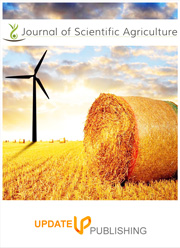Adaptability studies of garlic (Allium sativum) advanced lines
DOI:
https://doi.org/10.25081/jsa.2019.v3.5438Keywords:
Adaptability, garlic, Allium sativum, advance linesAbstract
The purpose of this research was to identify the most desirable verities adopted in different environmental conditions of the country. Five garlic advance line; NARC Garlic-1, NARC Garlic-3, NARC Garlic-4, NARC Garlic-5 along with ‘Lehsan Gulabi’ as check were evaluated at different locations along with NARC, Islamabad. Different morphological parameters; plant height, plant girth, leaf number per plant and leaf width were studied at four different growth stages. NARC Garlic-1 performed better as compared other advance lines and control tested.
Downloads
Download data is not yet available.
References
[1] Meer QP, Botha JL, Galmarini CR. Old and new crops within edible Allium. Proceedings of the first international symposium on edible Alliaceae. Acta Horticulturae. 1997; 433:17-31.
[2] Rabinowitch H. and Currah L. Allium crop science: recent advances. CABI, Int. Wallingford United Kingdom. 2002; 616 pp.
[3] Anonymous. Horticulture Division, Ministry of Agriculture, Government of India, New Delhi. 2012.
[4] Walters SA. Production method and cultivar effects on garlic over-wintering survival, bulb quality and yield. Horticulture Technology. 2008; 18(2): 286-289.
[5] El-Zemaity MS, Salama SI, Ahmed AA, Mahmoud ER. Some factors affecting the susceptibility of four stored garlic cultivars to infestation with Cryptoblabesgnidiella milliere. Arab Univ. J. Agric. Sci., 2009; 17: 185-192.
[6] Bradley KF, Rieger MA, Collins GG. Classification of Australian garlic cultivars by DNA finger printing. Aust J. Exp. Agri. 1996; 36: 613–618.
[7] Pooler MR, Simon PW. Characterization and classification of isozyme and morphological variation in a diverse collection of garlic clones. Euphytica. 1993; 68: 121–130.
[8] Fritsch RM, Friesen N. Evolution, domestication and taxonomy. In: Rabinowitch H.D. and Currah L. (eds), Allium Crop Science: Recent Advances. CABI Publishing, 2002; 65–30.
[9] Simon PW. The origins and distribution of garlic: How many garlics are there? USDA, ARS, Vegetable Crop Research Unit, Department of Horticulture, University of Wisconsin, Madison, WI 53706. 2001.
[10] Dhotre M, Allolli TB, Athani SI, Halemani LC. Genetic variability, character association and path analysis studiesin KharifOnion (Allium. cepa L.), Asian J. Hort.2010; 5:143-146.
[11] Asohk P, Sasikala K, Pal N. Association among growth characters, yield and bulb quality in Onion, Allium cepa L. Inter. J. Farm Sci. 2013; 3:22-29.
[12] Steel RGD, Torrie JH.Principles and Procedure of Statistics. McGraw Hill Book Co., Inc. Singapore, 1997; 173–177.
[13] Singh MC, Tiwari RS. Yield and quality attributes of garlic (Allium sativum L.) accessions. Haryana J. Hort. Sci. 1995; 24: 46–49.
[14] Al-Zahim M, Newbury HJ, Ford-Lloyd BV.Classification of genetic variation in garlic Allium sativum L. revealed by RAPD. Hort. science 1997; 32: 1102–1104.
[15] Menezes-Sobrinho JA, de Charchar JM, Aragao FAS.Morphological characterization of garlic germplasm by multivariate analyses of principal components and canonic variables. Horticultura Brasileira. 1999; 17: 96–101.
[16] Tiwari RS, Ankur Agrawal, Sengar SC, Agrawal A. Performance of garlic genotypes under Tarai Region of Uttaranchal. Progress Hort., 2017; 34(2):183-186.
[17] Futane NW, Jogdande ND, Gonge VS, Warade AD, Khandagal SS. Evaluation of garlic genotypes. Int., J. Agric. Sci., 2017; 2(1):2-5.
[2] Rabinowitch H. and Currah L. Allium crop science: recent advances. CABI, Int. Wallingford United Kingdom. 2002; 616 pp.
[3] Anonymous. Horticulture Division, Ministry of Agriculture, Government of India, New Delhi. 2012.
[4] Walters SA. Production method and cultivar effects on garlic over-wintering survival, bulb quality and yield. Horticulture Technology. 2008; 18(2): 286-289.
[5] El-Zemaity MS, Salama SI, Ahmed AA, Mahmoud ER. Some factors affecting the susceptibility of four stored garlic cultivars to infestation with Cryptoblabesgnidiella milliere. Arab Univ. J. Agric. Sci., 2009; 17: 185-192.
[6] Bradley KF, Rieger MA, Collins GG. Classification of Australian garlic cultivars by DNA finger printing. Aust J. Exp. Agri. 1996; 36: 613–618.
[7] Pooler MR, Simon PW. Characterization and classification of isozyme and morphological variation in a diverse collection of garlic clones. Euphytica. 1993; 68: 121–130.
[8] Fritsch RM, Friesen N. Evolution, domestication and taxonomy. In: Rabinowitch H.D. and Currah L. (eds), Allium Crop Science: Recent Advances. CABI Publishing, 2002; 65–30.
[9] Simon PW. The origins and distribution of garlic: How many garlics are there? USDA, ARS, Vegetable Crop Research Unit, Department of Horticulture, University of Wisconsin, Madison, WI 53706. 2001.
[10] Dhotre M, Allolli TB, Athani SI, Halemani LC. Genetic variability, character association and path analysis studiesin KharifOnion (Allium. cepa L.), Asian J. Hort.2010; 5:143-146.
[11] Asohk P, Sasikala K, Pal N. Association among growth characters, yield and bulb quality in Onion, Allium cepa L. Inter. J. Farm Sci. 2013; 3:22-29.
[12] Steel RGD, Torrie JH.Principles and Procedure of Statistics. McGraw Hill Book Co., Inc. Singapore, 1997; 173–177.
[13] Singh MC, Tiwari RS. Yield and quality attributes of garlic (Allium sativum L.) accessions. Haryana J. Hort. Sci. 1995; 24: 46–49.
[14] Al-Zahim M, Newbury HJ, Ford-Lloyd BV.Classification of genetic variation in garlic Allium sativum L. revealed by RAPD. Hort. science 1997; 32: 1102–1104.
[15] Menezes-Sobrinho JA, de Charchar JM, Aragao FAS.Morphological characterization of garlic germplasm by multivariate analyses of principal components and canonic variables. Horticultura Brasileira. 1999; 17: 96–101.
[16] Tiwari RS, Ankur Agrawal, Sengar SC, Agrawal A. Performance of garlic genotypes under Tarai Region of Uttaranchal. Progress Hort., 2017; 34(2):183-186.
[17] Futane NW, Jogdande ND, Gonge VS, Warade AD, Khandagal SS. Evaluation of garlic genotypes. Int., J. Agric. Sci., 2017; 2(1):2-5.
How to Cite
Raheel, A., Raheel Babar, H., Ullah, M. A., & Iqbal, A. Z. M. (2019). Adaptability studies of garlic (Allium sativum) advanced lines. Journal of Scientific Agriculture, 3, 19–21. https://doi.org/10.25081/jsa.2019.v3.5438
Issue
Section
Short Communication



 .
.